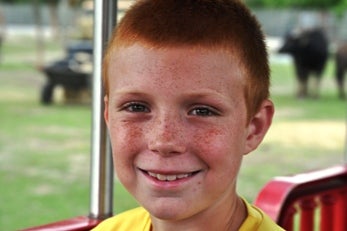CBIT
Jackson Glover is one of dozens of children who are being helped by an innovative therapy offered at Children’s of Alabama. The pediatric comprehensive behavioral intervention program for tic disorders (CBIT) is providing relief for children who experience the involuntary movements or vocal sounds commonly referred to as “tics.” In August 2011, 7-year-old Jackson was looking forward to beginning practice with his football team. “He just woke up one morning with his head shaking. It scared us to death. As we went through the weekend, it got worse and finally we took him to the overnight clinic on Sunday night. The doctors said it was a tic and it would go away. I wanted to make sure so made them do an MRI and run all sorts of neurological tests and they all came back clear,” said Jaimee Glover, Jackson’s mother. The Glovers were referred to Dr. Leon Dure, division director of Pediatric Neurology at Children’s of Alabama, but by the time of their scheduled appointment, Jackson’s tic had disappeared as quickly as it began. In March 2013, the tic returned, stronger than before. “It was really bad. He couldn’t get any relief from the time he opened his eyes in the morning, until he lay down at night to go to sleep,” Glover said. Making the situation even harder to deal with was the fact that Jackson was a pitcher for his baseball team. “He’s really a good pitcher and it was tough on him. People who didn’t understand would ask him what was going on, why he was always shaking his head. The social part was just very tough,” Glover said. The neurologist that Jackson had been seeing in Dothan suggested he begin medication to control the tic. “I just didn’t want him to have to take medication for the rest of his life, so I e-mailed Dr. Dure and asked him what he thought,” Glover said. Dr. Dure recommended that Jackson begin CBIT therapy at Children’s with occupational therapist Dr. Jan Rowe. The CBIT program is offered in partnership with the Pediatric Neurology through Children’s occupational therapy department. In a series of eight weekly sessions, Rowe works with patients to train them to become aware of their tics and to substitute a “competing” behavior when they feel the urge to tic. “We don’t ask them to suppress the tic because if they could do that, then they already would have. Many patients have a premonitory urge, a kind of sensory feeling or thought a split second before the tic occurs. The idea is to come up with a competing response or alternate behavior and put that alternate behavior in place of the tic when they feel that urge,” Rowe said. Although CBIT has previously been used with adults, it is a new approach for children. “Prior to this, the only real hope people had was medication for tics. They had horrendous side effects and it didn’t do that much. Parents and children alike are thrilled this therapy is out there. It’s like magic. It works amazingly well,” Rowe said. After one therapy session with Rowe, Jackson’s tic was markedly improved. “We went to see her the first time and by the time we got home he was 90 percent better. People at the ball field were just amazed. Jackson was determined the therapy would work. When he gets the urge to tic, he knows what to do and Ms. Jan has given him the exercises to deal with it. I just can’t say enough good things about her and Dr. Dure,” Glover said.







